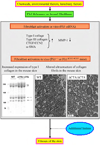The impact of Fli1 deficiency on the pathogenesis of systemic sclerosis
- PMID: 20663647
- PMCID: PMC3826615
- DOI: 10.1016/j.jdermsci.2010.06.008
The impact of Fli1 deficiency on the pathogenesis of systemic sclerosis
Abstract
Systemic sclerosis (SSc) is an autoimmune inflammatory disease with unknown etiology characterized by microvascular injury and fibrosis of the skin and internal organs. A growing body of evidence suggests that deficiency of the transcription factor Fli1 (Friend leukemia integration-1) has a pivotal role in the pathogenesis of SSc. Fli1 is expressed in fibroblasts, endothelial cells, and immune cells, and has important roles in the activation, differentiation, development, and survival of these cells. Previous studies demonstrated that Fli1 is downregulated in SSc fibroblasts by an epigenetic mechanism and a series of experiments with Fli1-deficient animal models revealed that Fli1 deficiency in fibroblasts and endothelial cells reproduces the histopathologic features of fibrosis and vasculopathy in SSc, respectively. In this article, we review the impact of Fli1 deficiency on the pathogenesis of SSc and discuss a new therapeutic strategy for SSc by targeting the transcription factor Fli1.
Copyright 2010 Japanese Society for Investigative Dermatology. Published by Elsevier Ireland Ltd. All rights reserved.
Figures






References
-
- Asano Y, Czuwara J, Trojanowska M. Transforming growth factor-beta regulates DNA binding activity of transcription factor Fli1 by p300/CREB-binding protein-associated factor-dependent acetylation. J Biol Chem. 2007;282:34672–34683. - PubMed
Publication types
MeSH terms
Substances
Grants and funding
LinkOut - more resources
Full Text Sources
Medical
Molecular Biology Databases

